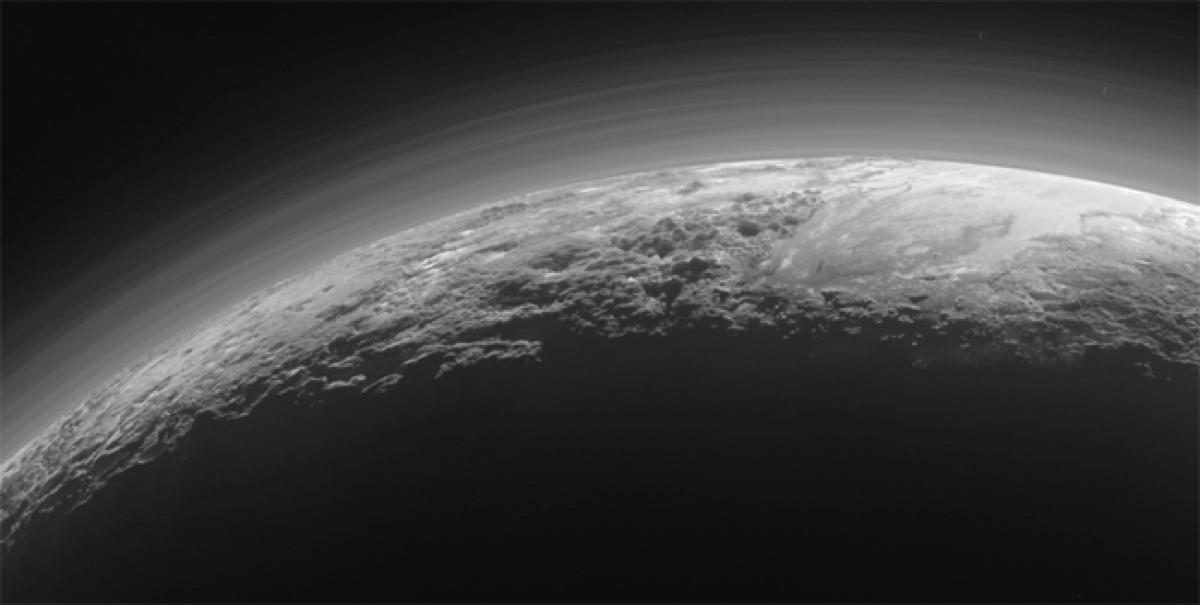Live
- Allu Arjun Thanks Fans in Patna, Teases 'Pushpa 2' Release
- Japan to strengthen measures against illegal part-time jobs
- Gahlot resignation: Delhi Congress calls AAP a sinking ship
- Consultative body on doctors' walkout fails to narrow differences in South Korea
- Honouring bravehearts: Army commemorates Nuranang Day
- 40,000 aspirants participate in army recruitment rallies across Jammu division
- Nigerian President Tinubu lauds PM Modi's efforts to amplify concerns of Global South
- Congress in Himachal to hold event in Bilaspur to mark two years at helm
- Hitaashee takes third title of the season, wins 14th leg of WPGT
- Group-3 exams in Wanaparthy district peacefully*
Just In

NASAs New Horizons space probe has spotted possible clouds hovering over Pluto, indicating that the weather on the icy dwarf planet is more complex than thought.
Washington: NASA's New Horizons space probe has spotted possible clouds hovering over Pluto, indicating that the weather on the icy dwarf planet is more complex than thought.
"Were excited about the exploration ahead for New Horizons, and also about what we are still discovering from Pluto flyby data," said Alan Stern, principal investigator from Southwest Research Institute in the US.
"Now, with our spacecraft transmitting the last of its data from last summers flight through the Pluto system, we know that the next great exploration of Pluto will require another mission to be sent there," said Stern.
Stern said that Plutos complex, layered atmosphere is hazy and appears to be mostly free of clouds, but the team has spied a handful of potential clouds in images taken with New Horizons cameras during its historic Pluto flyby of in July last year.
"If there are clouds, it would mean the weather on Pluto is even more complex than we imagined," Stern said.
Scientists already knew that Plutos icy surface below that atmosphere varied widely in brightness.
Data from the flyby not only confirms that, it also shows the brightest areas (such as sections of Plutos large heart-shaped region) are among the most reflective in the solar system.
"That brightness indicates surface activity," said Bonnie Buratti, a science team co-investigator from NASAs Jet Propulsion Laboratory.
While Pluto shows many kinds of activity, one surface process apparently missing is landslides. However, they have been spotted on Plutos largest moon, Charon, itself some 1,200 kilometres across.
"Weve seen similar landslides on other rocky and icy planets, such as Mars and Saturns moon Iapetus, but these are the first landslides weve seen this far from the sun, in the Kuiper Belt," said Ross Beyer, researcher from the SETI Institute and NASA Ames Research Centre in California.
Hubble Space Telescope data suggests that 2014 MU69, a small Kuiper Belt object (KBO) about 1.6 billion kilometres beyond Pluto, is as red, if not redder, than Pluto.
This is the first hint at the surface properties of the far flung object that New Horizons will survey on January 1, 2019.
"The reddish colour tells us the type of Kuiper Belt object 2014 MU69 is," said Amanda Zangari, a New Horizons post-doctoral researcher from Southwest Research Institute.
"The data confirms that on New Years Day 2019, New Horizons will be looking at one of the ancient building blocks of the planets," said Zangari.
The New Horizons spacecraft is currently 5.5 billion kilometres from Earth and about 540 million kilometres beyond Pluto, speeding away from the sun at about 14 km every second.
New Horizons has covered about one-third of the distance from Pluto to its next flyby target, which is now about one billion kilometres ahead.

© 2024 Hyderabad Media House Limited/The Hans India. All rights reserved. Powered by hocalwire.com







